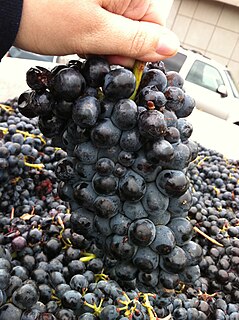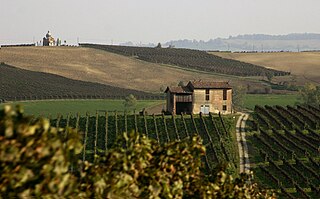
Pinot blanc is a white wine grape. It is a point genetic mutation of Pinot noir. Pinot noir is genetically unstable and will occasionally experience a point mutation in which a vine bears all black fruit except for one cane which produces white fruit.

Carignan is a red grape variety of Spanish origin that is more commonly found in French wine but is widely planted throughout the western Mediterranean and around the globe. Along with Aramon, it was considered one of the main grapes responsible for France's wine lake and was a substantial producer in jug wine production in California's Central Valley but in recent years, it has been reborn as a flagship wine for many cellars in the south of France as well as in Catalonia.

Nebbiolo is an Italian red wine grape variety predominantly associated with its native Piedmont region, where it makes the Denominazione di Origine Controllata e Garantita (DOCG) wines of Barolo, Barbaresco, Roero, Gattinara, Carema and Ghemme. Nebbiolo is thought to derive its name from the Italian nebbia or Piedmontese nebia, meaning "fog". During harvest, which generally takes place late in October, a deep, intense fog sets into the Langhe region where many Nebbiolo vineyards are located. Alternative explanations refers to the fog-like glaucous veil that forms over the berries as they reach maturity, or that perhaps the name is derived instead from the Italian word nobile, meaning noble. Nebbiolo produces lightly-colored red wines which can be highly tannic in youth with scents of tar and roses. As they age, the wines take on a characteristic brick-orange hue at the rim of the glass and mature to reveal other aromas and flavors such as violets, tar, wild herbs, cherries, raspberries, truffles, tobacco, and prunes. Nebbiolo wines can require years of aging to balance the tannins with other characteristics.

Barbera is a red Italian wine grape variety that, as of 2000, was the third most-planted red grape variety in Italy. It produces good yields and is known for deep color, full body, low tannins and high levels of acidity.

Pinot Meunier, pronounced [pi.no mø.nje], also known as Meunier or Schwarzriesling, is a variety of black wine grape most noted for being one of the three main varieties used in the production of Champagne. Until recently, producers in Champagne generally did not acknowledge Pinot Meunier, preferring to emphasise the use of the other noble varieties, but now Pinot Meunier is gaining recognition for the body and richness it contributes to Champagne. Pinot Meunier is approximately one-third of all the grapes planted in Champagne. It is a chimeric mutation of Pinot: its inner cell layers are composed of a Pinot genotype which is close to Pinot noir or Pinot gris; the outer, epidermal, layer is however made up of a mutant, distinctive, genotype. Pinot Meunier was first mentioned in the 16th century, and gets its name and synonyms from flour-like dusty white down on the underside of its leaves.

Verdicchio is a white Italian wine grape variety grown primarily in the Marche region of central Italy. The name Verdicchio derives from verde and refers to the slight green/yellow hue that wines made from the grape can have.

Italian wine is produced in every region of Italy, home to some of the oldest wine-producing regions in the world. Italy is the world's largest producer of wine, with an area of 702,000 hectares under vineyard cultivation, and contributing a 2013–2017 annual average of 48.3 million hl of wine. In 2018 Italy accounted for 19 percent of global production, ahead of France and Spain. Italian wine is both exported around the world and popular domestically among Italians, who consume an average of 42 litres per capita, ranking fifth in world wine consumption.
Freisa is a red Italian wine grape variety grown in the Piedmont region of north-west Italy, primarily in Monferrato and in the Langhe, but also further north in the provinces of Turin and Biella. Freisa is a vigorous and productive vine whose round, blue-black grapes are harvested in early October. The three-lobed leaves are relatively small and the bunches are elongated in form. By the 1880s it had become one of the major Piedmontese grapes, and in that period its cultivation was stimulated by the vine’s resistance to the downy mildew caused by the Plasmopara viticola fungus. Wines made from the Freisa grape are red and usually somewhat sweet and lightly sparkling, or foaming. Still and fully sparkling versions are also produced, however, as are dry and more decidedly sweet styles. In the Canavese there is also a rosé which can be made primarily from Freisa according to Denominazione di origine controllata (DOC) regulations.

Aleatico is a red Italian wine grape variety. It is notable for being the primary grape in the cult wine Aleatico di Portoferraio made in Elba. In Chile is known as Red Moscatel. The grape has also been cultivated at Mudgee in New South Wales and California.
Cortese is a white Italian wine grape variety predominantly grown in the southeastern regions of Piedmont in the provinces of Alessandria and Asti. It is the primary grape of the Denominazione di origine controllata (DOC) wines of Cortese dell'Alto Monferrato and Colli Tortonesi as well as the Denominazione di Origine Controllata e Garantita (DOCG) wine of Cortese di Gavi. Significant plantings of Cortese can also be found in the Lombardy region of Oltrepò Pavese and in the DOC white blends of the Veneto wine region of Bianco di Custoza. Cortese has a long history in Italian viticulture with written documentation naming the grape among the plantings in a Piedmontese vineyard as early as 1659. The grape's moderate acidity and light flavors has made it a favorite for the restaurants in nearby Genoa as a wine pairing with the local seafood caught off the Ligurian coast.

Piemonte wine is the range of Italian wines made in the region of Piedmont in the northwestern corner of Italy. The best-known wines from the region include Barolo and Barbaresco. They are made from the Nebbiolo grape. These wines are ideal for storage and a well-aged Barolo for instance may leave a feeling of drinking velvet because the tannins are polished and integrated more and more into the wine. As the wine matures the colour becomes more brownish and rust-red.

Friuli-Venezia Giulia wine is wine made in the northeastern Italian region of Friuli-Venezia Giulia. Once part of the Venetian Republic and with sections under the influence of the Austro-Hungarian Empire for some time, the wines of the region have noticeable Slavic and Germanic influences. There are 11 Denominazione di origine controllata (DOC) and 3 Denominazione di Origine Controllata e Garantita (DOCG) in the Friuli-Venezia Giulia area. The region has 3 Indicazione Geografica Tipica (IGT) designations Alto Livenza, delle Venezie and Venezia Giulia. Nearly 62% of the wine produced in the region falls under a DOC designation. The area is known predominantly for its white wines which are considered some of the best examples of Italian wine in that style. Along with the Veneto and Trentino-Alto Adige/Südtirol, the Friuli-Venezia Giulia forms the Tre Venezie wine region which ranks with Tuscany and Piedmont as Italy's world class wine regions.
Bombino bianco is a white Italian wine grape variety planted primarily along Italy's Adriatic coast line, most notably in Apulia. The vine is prone to high yields and often produces neutral flavor wines. The grape is known under many synonyms throughout Italy including Debit and Pagadebit, names which came from the grape's reputation for being a high yielding and reliable crop for vineyard owners to grow that would assure them that on each vintage they could pay off their debts.

The Colli Piacentini is an Italian wine region located at the western end of Emilia-Romagna. In 1967, it was given the Denominazione di origine controllata (DOC) quality designation. Within its boundaries are several smaller DOCs including Colli Piacentini Gutturnio, Monterosso Val D'Arda DOC, Trebbianino Val Trebbia DOC and Val Nur del Colli Piacentini DOC. The region has a long history of winemaking with fossilized vine roots and grape seeds excavated from the region showing viticulture taking place as early as 2000 BC. In Roman times, Julius Caesar's father-in-law Lucius Calpurnius Piso Caesoninus, grew grapes in the Piacenza hills.

Incrocio Manzoni or Manzoni grapes is a family of grape varieties named after Professor Luigi Manzoni (1888-1968) of Italy's oldest school of oenology located in Conegliano, in the Veneto region. Manzoni created the new grape varieties by selecting, crossing and grafting vines from various vineyards during the 1920s and 1930s. The family includes both white and red grape varieties. Although most Manzonis are grown in northeastern Italy, they are mainly grown in the Piave area of Province of Treviso and are only now starting to be sold commercially in Europe and the United States.
Marzemina bianca is a white Italian wine grape variety that is grown in the Veneto region of northeastern Italy. Ampelographers believe that the grape is a natural crossing of the Trentino wine grape Marzemino and the Soave wine grape Garganega. This parent-offspring relationship between Marzemina bianca and Marzemino makes the variety distinct from grapes like Pinot blanc and Grenache blanc which are other color mutations of Pinot noir and Grenache, respectively. DNA analysis has confirmed that the Veneto grape Raboso Veronese is the offspring of Marzemina bianca and Raboso Piave.
Canari noir is a red French wine grape variety that has been historically grown in the Ariège department in the foothills of the French Pyrénées. However DNA profiling in 2001 showed that plantings of a grape called Gamay Luverdon growing in the Italian wine region of Piedmont were in fact plantings of Canari noir. Across the Pyrénées in Spain, the grape variety known as Batista was also found to be identical to Canari noir. Like Pinot noir and Grenache, Canari noir has color mutations known as Canari blanc and Canari gris.

Prié blanc is a white Italian wine grape variety that is grown almost exclusively in the Valle d'Aosta DOC of northwest Italy. The Valle d'Aosta varietal wine Blanc de Morgex et de La Salle is made from Prié blanc grapes.
Barbera del Sannio is a red Italian wine grape variety that is grown in the Campania region of southern Italy. Despite the similarities in name and appearance, the grape has no close genetic relationship with the Piedmont wine grapes Barbera or Barbera bianca or the Sardinian wine grape Barbera Sarda and is, instead, more closely related to the Campanian varieties Casavecchia and Catalanesca and the Apulian grape Nero di Troia.
Barbera Sarda is a red Italian wine grape variety that is grown on the island of Sardinia where it often used to add acidity to blends. Despite the similarities in their names, there is no known close genetic relationship between the Sardinian Barbera and the notable Piedmontese wine grape variety Barbera. Nor does there seem to be any close relationship with other grapes names Barbera, such as Barbera bianca and Barbera del Sannio.














